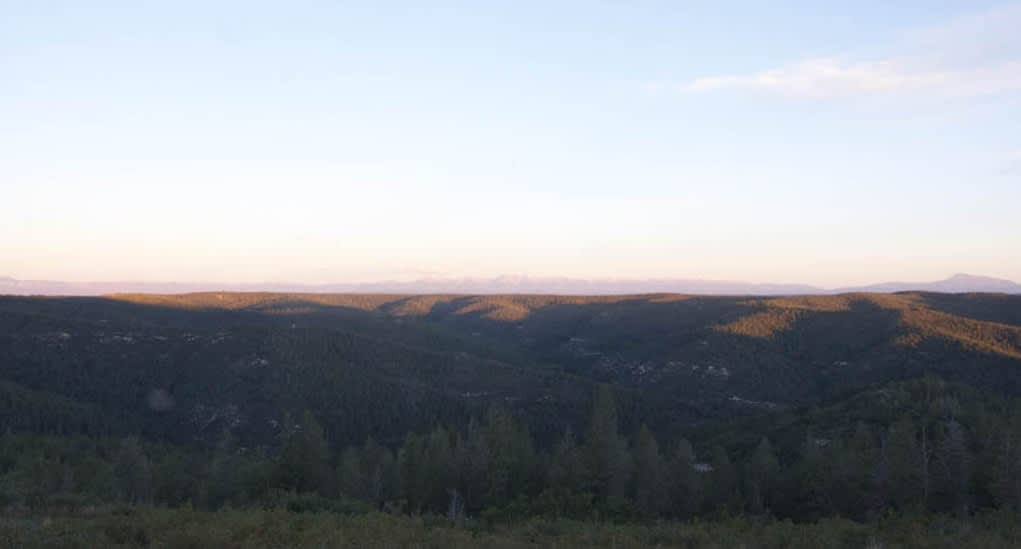The Anatomy of Elk Hunting: Part One
Josh Wolfe 10.23.13

We set out that first morning, the wind swirling around us, the temperature, hovering somewhere around 25 degrees, made my teeth chatter. The day before I’d only slightly panicked as I packed my bag for New Mexico, unable to find my long johns, knowing the drastic weather change would surely alter my mood, and not for the better. Though as my guide Mike White and I bounced up the rocky, rutted roads at the NRA Whittington Center in Raton, New Mexico, cold and wind and climate in general skittered out of my mind and into the dark timber, much like the tendency of our quarry we would be chasing over the next several days.
After climbing (in the truck) for a few miles and a few thousand feet, we arrived at Deer Cabin, a one-room log cabin overlooking a whole lot of acreage (note: being from the Southeast, I’m used to hunting tracts of land ranging anywhere from 40 to 4,000 acres, certainly not the likes of the Whittington Center, which is 33,300). Being my first elk hunt, or really the first time I’d ever looked for elk in the wild, I stood dumbly in a dark corner of the cabin, waiting for the sun to rise.
“We’ll glass here until the sun comes up and the shadows are gone,” said Mike.

No problem, I thought. Because elk, getting on to the size of a horse, will be easy to spot, especially against the green background of the surrounding timber.
In my mind’s eye, I was already seeing large horns dwarfing the yearling pines and mountain mahogany a half mile away. Again I thought wrongly that, much like deer hunting, movement would catch my eye and give away their location. I would be the first to spot on elk.
Except none of this was true. In fact, my eyes were burning so badly from straining to make out animals that simply weren’t there, I had to shut them for short periods as my tear ducts were already working overtime.
“Okay, I see one. A bull,” Mike said, nodding toward the adjacent mountainside. “See that rocky outcropping? Right below the top? Now slide down that tree line towards three o’clock. He’s facing south.”
I expected to instantly spot this monster of an animal, though after a few minutes of seeing nothing I considered lying so Mike wouldn’t think I was completely incompetent. I readjusted my binoculars and rested against the windowsill to steady my arms, and slowly scanned the general vicinity where I thought he might be.
“I see him,” I nearly gasped (I’d been holding my breath; not a good idea for a flatlander at that altitude). Sure enough, about a half mile away, I could make out the brown blur of a bull elk through my 8x binos. It was a small lesson in judging the scope and sheer size of the landscape. No matter how big they are up close and how many are roaming the property, the Whittington Center is the whale and the elk Jonas. And it would be much like that biblical story, for the next three days we hunted hard, only to see rear ends heading into the timber as the sun rose and the darkness fell away.

All day we rode around the ranch, stopping periodically to hike out to overlooks and glass canyons and distant hillsides. Sometimes we’d see an elk; small bulls mostly. Mule deer were in abundance and the beautiful Merriam turkeys (some Merriam-Rio hybrids) sauntered in front of the truck at regular intervals.
Mike was a wealth of knowledge, naming the various flora and fauna that I am not accustomed to, pointing to distant mountains and surrounding landmarks (Capulin Volcano, Sangre de Cristo Mountains, Philmont Scout Ranch) and explaining their geography and significance. An Abert’s squirrel here, and did you see that wallow over there? That’s where elk will escape the midday heat. We talked about the history of the NRA Whittington Center and what they do for hunters, shooters, and the local economy in Raton.
And then, on one of those sunny afternoons three days into the hunt, we (Mike and I were now joined by Logan, the ranch’s intern) heard a bugle close by as we sat upon a perch overlooking a canyon called Pevov. Mike slipped back into the woods where we had walked in along a spine. The smell of elk was so heavy in there I was reminded of walking through a horse barn. He came back moments later with nothing to report, but as the sun swung along the southern hemisphere, gradually making its way to bed down beyond the western horizon, a glimmer caught my eye to the right. Cows slowly trickled out onto a point 550 yards away and then the shining spectacle of antlers followed closely behind.
“That’s a good bull,” Mike said. “Really good. We’re gonna try and take him.”
To read part two of this story, click here.
Note added 10/31/2013: This article has been updated to indicate that the ranch’s intern accompanied the author and Mike on the excursion three days into the hunt.

